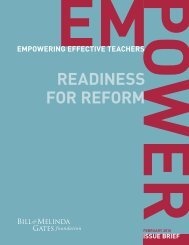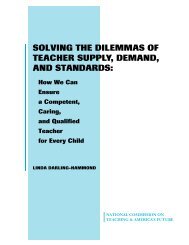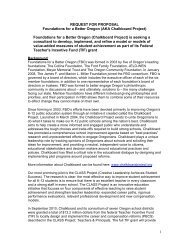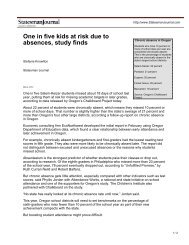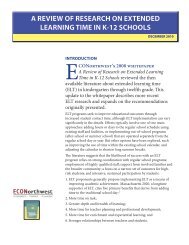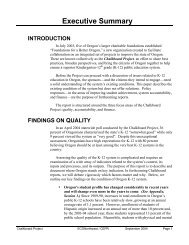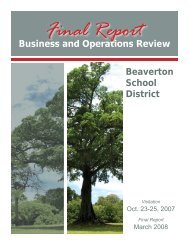Tapping the Potential - Alliance for Excellent Education
Tapping the Potential - Alliance for Excellent Education
Tapping the Potential - Alliance for Excellent Education
You also want an ePaper? Increase the reach of your titles
YUMPU automatically turns print PDFs into web optimized ePapers that Google loves.
TA P P I N G T H E P O T E N T I A L : R E TA I N I N G A N D D E V E L O P I N G H I G H - Q U A L I T Y N E W T E A C H E R SOn this point <strong>the</strong>re is broad, even international,agreement: Once on <strong>the</strong> job, allbeginners must learn to teach to establishedstandards, evaluate <strong>the</strong> effects of <strong>the</strong>irinstruction on student per<strong>for</strong>mance, usestudent achievement data <strong>for</strong> planning andcurriculum, tailor instruction to addressspecific learning needs, and learn how tothrive in <strong>the</strong> culture of <strong>the</strong>ir school. 51 Thiskind of learning can only happen withstrong support and assessment—that is,with comprehensive induction.The Short End of <strong>the</strong> Stick: OnceAgain, Poor Schools Suffer MostA major result of teacher attrition andinadequate induction is that poor, urban,and minority children are taught by lessexperienced, less qualified teachers whodo not stay long enough to become <strong>the</strong>expert, high-quality teachers <strong>the</strong>ir studentsdesperately need. High-povertyschools have proportionally greater numbersof teachers with less than three yearsof experience than affluent schools. 52High-poverty schools with high percentagesof students of color are more likelyto employ teachers who are on emergencywaivers and who are not certified in<strong>the</strong> subject <strong>the</strong>y teach. 53 At <strong>the</strong> turn of<strong>the</strong> millennium, urban and poor childrenin <strong>the</strong> United States had only a 50 percentlikelihood of being taught math andscience by a teacher with a college majorin those subjects. 54In <strong>the</strong> words of <strong>the</strong> <strong>Education</strong> Trust:No matter which study you examine,no matter which measure of teacher qualitiesyou use, <strong>the</strong> pattern is always <strong>the</strong>same—poor students, low-per<strong>for</strong>mingstudents, and students of color are farmore likely than o<strong>the</strong>r students to haveteachers who are inexperienced, uncertified,poorly educated, and under-per<strong>for</strong>ming.Many of those teachers demonstratemost or all those un<strong>for</strong>tunate qualitiesat <strong>the</strong> same time. 55There are several reasons why highpovertydistricts rarely get quality teachersand often lose <strong>the</strong> ones <strong>the</strong>y have. Themost obvious factor is a lack of funds topay teachers <strong>the</strong> competitive wages <strong>the</strong>ycan find in wealthier schools. A 2003report by Levin and Quinn of <strong>the</strong> NewTeacher Project revealed that urbanschools often lose <strong>the</strong>ir brightest candidates,who actually want to teach <strong>the</strong>re,during a lengthy, bureaucratic hiringprocess. 56 Poor schools often have <strong>the</strong>most challenging working conditions,prompting many teachers to move too<strong>the</strong>r schools or leave teaching altoge<strong>the</strong>r.In 2002, Hanushek, Kain, and Rivkinargued in a National Bureau of EconomicResearch report that hard-to-staff schoolsstruggle to recruit and keep high-qualityteachers precisely because those districtsfail to provide effective training, valuableinduction programs, and a generally supportiveteaching environment. 57In a 2004 report by <strong>the</strong> HarvardProject on <strong>the</strong> Next Generation ofTeachers, researchers found that newteachers’ decisions to transfer out of lowincomeschools rested on <strong>the</strong> extent towhich those schools supported <strong>the</strong>m withwell-matched mentors, guidance in usingcurriculum, and positive hiring processes.“Given <strong>the</strong> many challenges of working inlow-income schools,” <strong>the</strong> report concludes,“teachers need to have broad, substantivesupport from a range of experiencedcolleagues. At a minimum, newteachers in <strong>the</strong>se schools need substantive,structured, regular interactions wi<strong>the</strong>xpert, veteran colleagues.” 58 Becauseteachers in poor schools receive so littleComprehensive inductionintegrates beginners into<strong>the</strong> profession by guiding<strong>the</strong>ir work, fur<strong>the</strong>rdeveloping <strong>the</strong>ir skills, andevaluating <strong>the</strong>irper<strong>for</strong>mance during <strong>the</strong>first few years of teaching.New teachers’ decisions totransfer out of low-incomeschools rested on <strong>the</strong>extent to which thoseschools supported <strong>the</strong>mwith well-matchedmentors, guidance in usingcurriculum, and positivehiring processes.9



